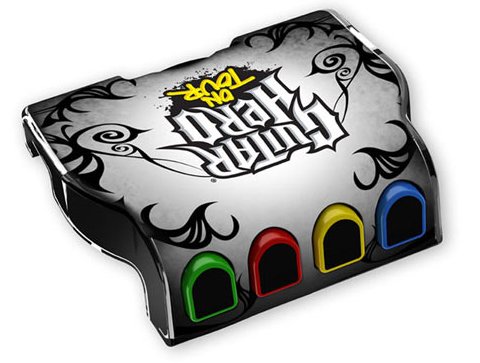Description
The Guitar Hero On Tour grip is a mechanism that comes with the game Guitar Hero On Tour. The game is for the Nintendo DS and falls into the simulator game genre where players play a virtual guitar by hitting the notes that come down the screen. They hold the correct coloured ‘note’ on the grip and ‘strum’ the note on the DS screen.
The grip consists of:
· The main base
· Strap
· Four coloured buttons or ‘notes’
· Plectrum
· Dock
The grip is approximately (H, W, D) 80 x 95 x 29 (mm) and weighs 0.1kg.
The Product: What Makes It Bad?
To begin with, the grip is designed to slot into the back on the DS via a dock. Because there are multiple versions of the DS out, the grip has to come with an adapter so that it may dock with older versions of the DS, such as my own. At first this is a straight forward process, although slightly time consuming as rather than simply having the adapter slip easily on, you have to undo some screws, place the adaptor on, then tighten the screws again. However, after a couple of times using the adaptor and having to take it off because my sisters DS doesn’t require the adaptor, the screws wore away extremely quickly and now one of them does not screw in at all. This has more or less ruined the entire docking process and can only be achieved now holding the adaptor in place then quickly sliding it in to the DS, without it coming off.
Attention and Affordance
On first looking at the grip, it appears slightly confusing as to how it docks with the DS and how you are supposed to hold it once it’s in place. Also if you are left handed, it’s difficult to figure out how to change the options so that you can play comfortably.
Mapping
The buttons which are used for ‘notes’ in the game are easily identifiable due to their colours and shape. At first the buttons seem well placed, however when it comes to playing the game, it quickly becomes uncomfortable and annoying to handle. The buttons are too small and too close together, leading to bad game play experience and strenuous fingers.
The grip itself is designed in too smaller fashion. It’s true that the grip is designed to portable, so that it can be played anywhere, but the grip needs to be bigger. For children with smaller hands, it would probably accommodate to well, but in consideration to older audiences, the grip fails to perform. Your fingers go over the top of the buttons, which means you have to curl them back in order to hit the notes. Strangely however, the button that the little finger is responsible for pressing is too far for it to reach. This leads to bad game play experience and stress of the fingers.
When you first enter the game, a health warning appears telling the user to keep their wrist straight when playing. But when it comes down to it, it’s extremely difficult to actually keep you wrist straight when playing, unless you’re holding you entire arm out to the side which soon becomes too difficult a position to maintain. The designers clearly did not take into consideration the mapping of the entire grip so that it would comfortable to play without having to hold you limbs up in awkward ways.
Aesthetics
In terms of looks, the grip doesn’t look very attractive at all when attached to the bottom of the DS. The strap is far too large for such a small piece of equipment and also the adaptor prevents the grip from docking fully with the DS, leave gaps between the grip and the DS.
The plectrum that comes with the grip is bland and boring, in no way representing the game. Not only this, but after being used a few times, the stylus at the end of the plectrum for use on the touch screen has more or less broken off and the plastic body of the plectrum has been damaged by simply just playing the game.
Conclusion
In conclusion to this product analysis, I personally would not recommend this version of the game to DS users, instead directing them to later versions of the game that have been developed in ways that hopefully lead to better user experience. However it’s difficult to give this product such a bad review, considering it was the first of its kind to enter the market.
















